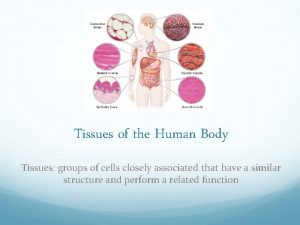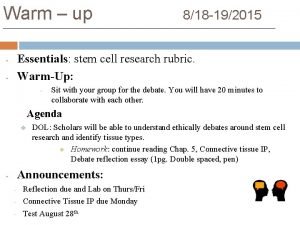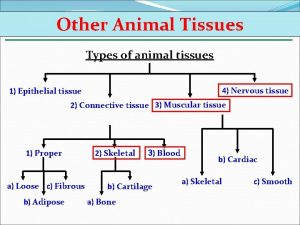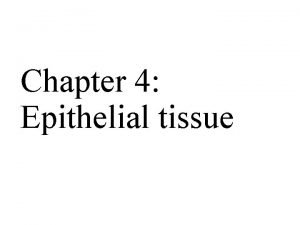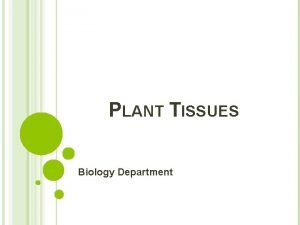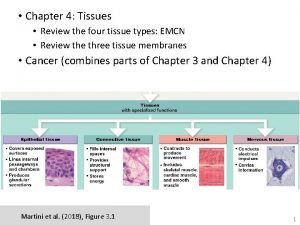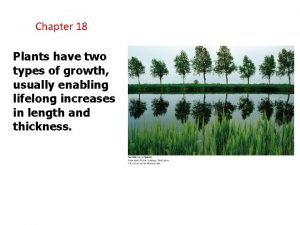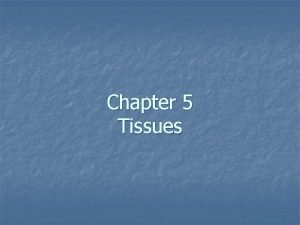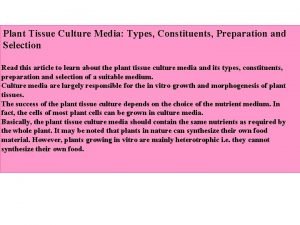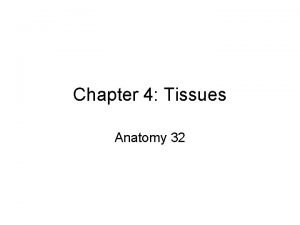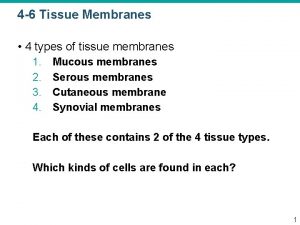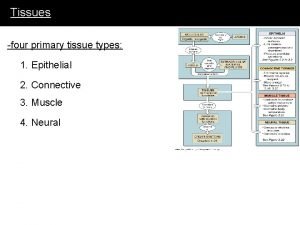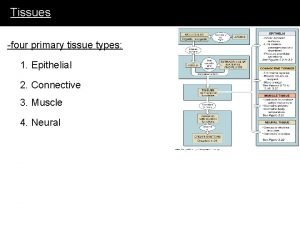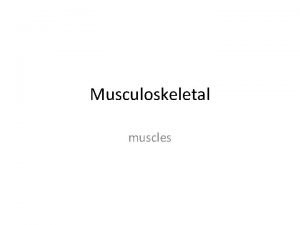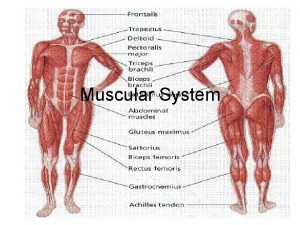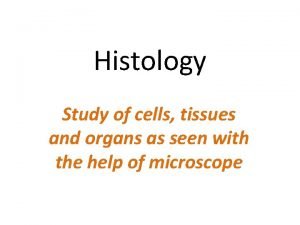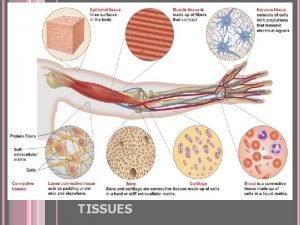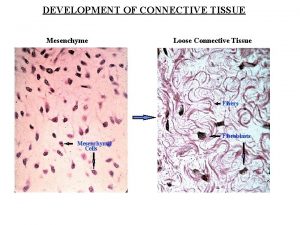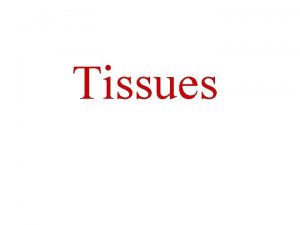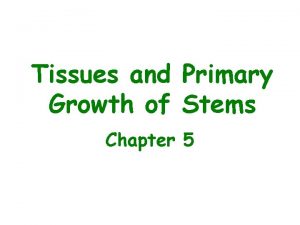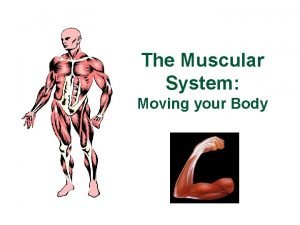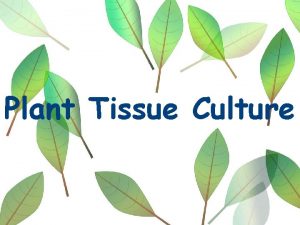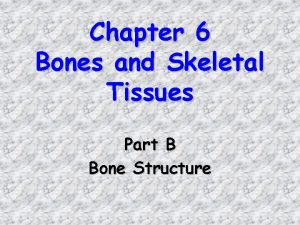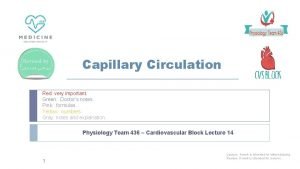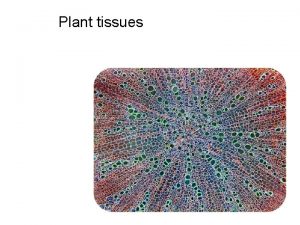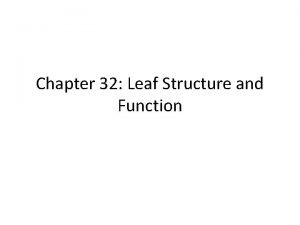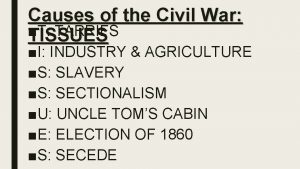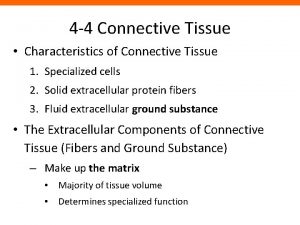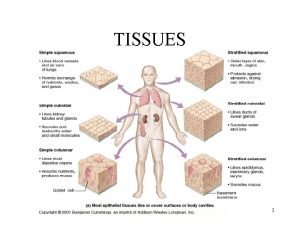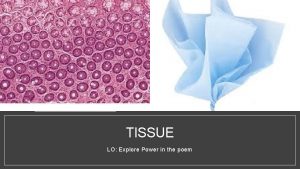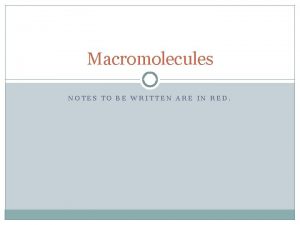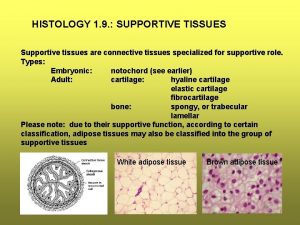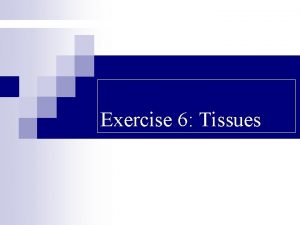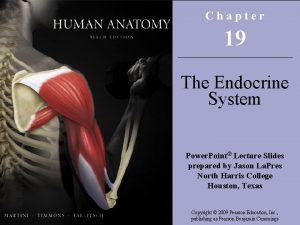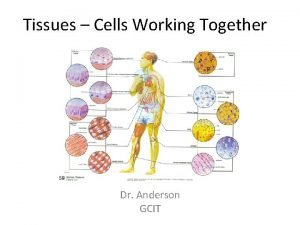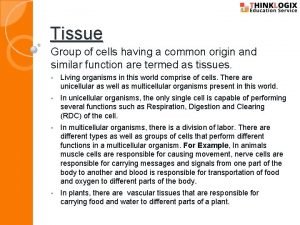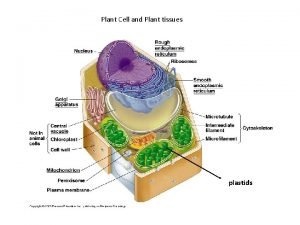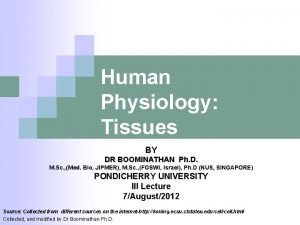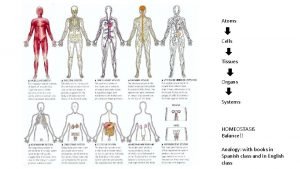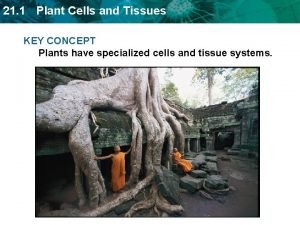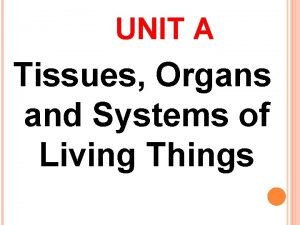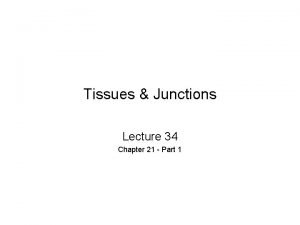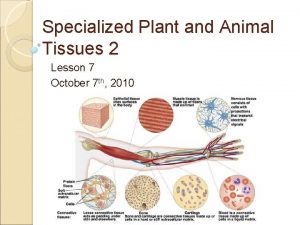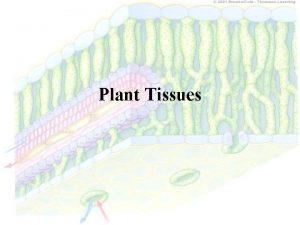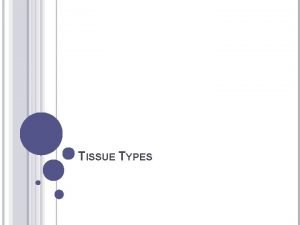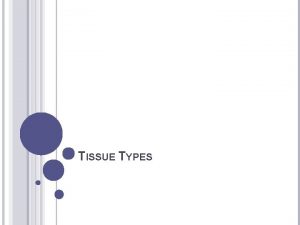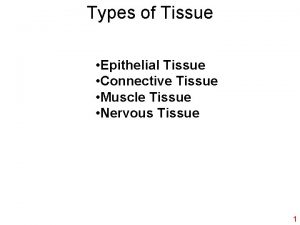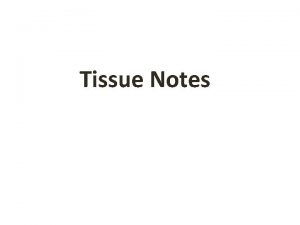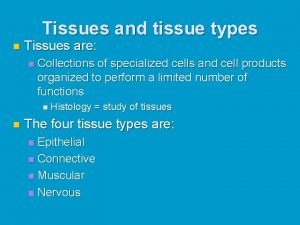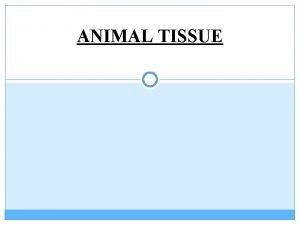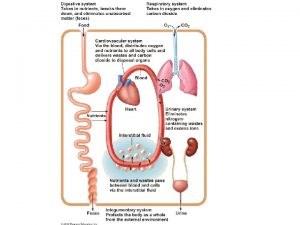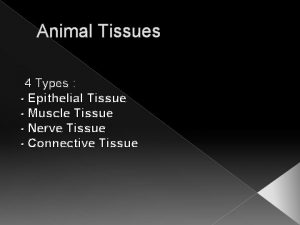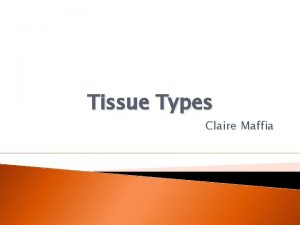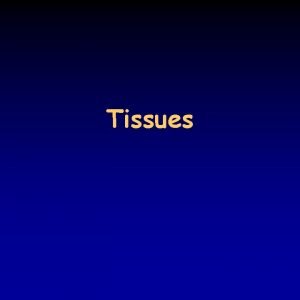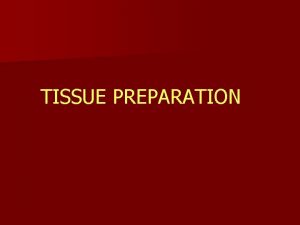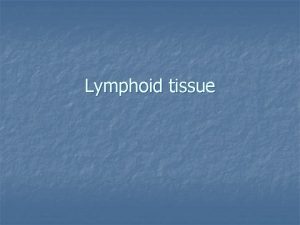Tissues 1 Tissues and tissue types l Tissues







































































- Slides: 71

Tissues 1

Tissues and tissue types l Tissues are: ¡Group of cells similar in structure an function ¡Tissues are organized into organs ¡Histology = study of tissues l The four tissue types are: ¡Epithelial ¡Connective ¡Muscular ¡Nervous 2

Functions of epithelium l Physical protection l Secretion l Sensory perception l Absorption l Filtration l Excretion 3

Epithelial tissue l Includes glands and epithelium ¡Glands are secretory l Avascular l Polarity l Regeneration l Cellularity l Supported by connective tissue ¡Attached to a basement membrane 4

5

Specializations of epithelium ¡Ciliated ¡Microvilli ¡Stereocilia ¡Flagella 6

Classification of epithelia l Number of cell layers ¡Simple ¡Stratified l Shape of apical surface cells ¡Squamous ¡Cuboidal ¡Columnar 7

8

9

10

Cuboidal Epithelia 11

12

Cuboidal Epithelia 13 Figure 4. 4 b

Transitional Epithelium 14 Figure 4. 4 c

15

Columnar Epithelia 16 Figure 4. 5 a

17

Columnar Epithelia 18 Figure 4. 5 b

19

Columnar Epithelia 20 Figure 4. 5 c

Glandular epithelia l Epithelium that secrete substances l Exocrine glands ¡Secrete through ducts onto the surface of the gland l Endocrine glands ¡Release hormones into surrounding fluid. Ductless glands. 21

22

Part 2 23

Connective Tissues 24

Connective tissue functions and classification: l Protects l Supports l Bind tissues together l Classification: l Embryonic ¡Mesenchyme ¡Loose connective tissue, mucous l Adult 25

A Classification of Adult Connective Tissues 26

Connective tissues characteristics l No free surface l Vascular ¡Scanty in tendons ¡Except cartilage l Supports the body l Maintain body form 27

Components of the connective tissue 1)Extracellular matrix ¡Ground substance l. Amorphous l. Binds cells to fibers l. Colorless l. Homogeneous l. Liquid, semisolid, gel-like, or hard 28

Matrix l Fibers ¡Collagen (white) l. Most abundant l. Brings flexibility and strength to the tissue l. Thicker one ¡Elastic (yellow) l. Brings elasticity to the tissues l. Can stretch and recoil 29

Fibers l Reticular ¡Thinnest one ¡Found in smooth muscle and framework of the organs ¡Brings flexibility to organs that need changes in volume 30

31

32

Components of the connective tissue 2) Cells ¡Fibroblast lmost abundant l. Synthesis of fibers and ground substance ¡Macrophage l. Phagocytic capacity 33

Components of the connective tissue ¡Adipocytes l. Closely packed l. Signet ring cell l. Nucleus eccentric and flat l. Mesenchymal cells ¡Mast cells l. Releases histamin l. Responsible for allergic reactions ¡Lymphocytes, etc 34

The Cells and Fibers of Connective Tissue Proper 35

Connective tissue proper l Classified as loose or dense l Loose l Areolar tissue l Adipose tissue l Reticular tissue l Rich blood supply 36

Connective tissue proper l Dense ¡Dense regular ¡Dense irregular ¡Elastic ¡Poor blood supply 37

Connective Tissue in Embryos 38

39

40

41

42

Dense Connective Tissues 43 Figure 4. 12 a

Dense Connective Tissues 44 Figure 4. 12 b

Dense Connective Tissues 45 Figure 4. 12 c

46

47

48

Bone, or osseous tissue l Has osteocytes and osteoblasts l Lacuna l Little ground substance l Dense mineralized matrix l Richly Vascularized 49

Bone 50

Part 3 51

Supporting connective tissues: Cartilage ¡Cells called chondrocytes or chondroblasts ¡Cells found in lacunae ¡Firm matrix ¡Avascular ¡Three types: hyaline, elastic, fibrocartilage 52

Types of Cartilage 53

54

Types of Cartilage 55

56

Types of Cartilage 57

58

Fluid connective tissues • Blood – Red blood cells, white blood cells and platelets – Plasma is the fluid matrix 59

Formed Elements of the Blood 60

61

Muscle tissue l Specialized for contraction l Three types ¡Skeletal ¡Cardiac ¡Smooth 62

Skeletal muscle l Cells are multinucleate, long, cylindrical l Presence of striation l Voluntary muscle 63

Muscle Tissue - Skeletal 64

65

Cardiac muscle l Cells: ¡Long, ¡ 1 or 2 nucleus ¡Branching cells l Intercalated discs l Presence of striation l Involuntary muscle 66

Muscle Tissue - Cardiac 67

68

Smooth muscle tissue l Cells ¡Fusiform ¡One central nucleus l Non-striated l Involuntary muscle l Forms the wall of hollow organs 69

Muscle Tissue - Smooth 70

71
 Body tissues chapter 3 cells and tissues
Body tissues chapter 3 cells and tissues The four major categories of tissues are
The four major categories of tissues are Body tissues chapter 3 cells and tissues
Body tissues chapter 3 cells and tissues Body tissues chapter 3 cells and tissues
Body tissues chapter 3 cells and tissues Cells form tissues. tissues form __________.
Cells form tissues. tissues form __________. How is aerolar tissue different than aerenchyma tissue?
How is aerolar tissue different than aerenchyma tissue? What are the 4 types of tissues
What are the 4 types of tissues Types of tissues
Types of tissues Types of tissues
Types of tissues Types of tissues
Types of tissues Meristematic tissue
Meristematic tissue Ground tissue definition
Ground tissue definition Types of cells in loose connective tissue
Types of cells in loose connective tissue Identify tissue
Identify tissue What are the primary tissue types
What are the primary tissue types Dermal tissue types
Dermal tissue types Four principal types of tissue
Four principal types of tissue Tissue culture media types
Tissue culture media types Blood tissue types
Blood tissue types 4 types of tissue membranes
4 types of tissue membranes Four primary tissue types
Four primary tissue types Types of exocrine glands
Types of exocrine glands Types of muscle tissue
Types of muscle tissue Types of muscle tissue
Types of muscle tissue Pseudostratified columnar epithelium location
Pseudostratified columnar epithelium location Josh wright haematology
Josh wright haematology Epithelial tissue
Epithelial tissue Connective tissue cells
Connective tissue cells Four major tissues
Four major tissues Xylem in stem
Xylem in stem Types of muscle tissue
Types of muscle tissue Types of callus in plant tissue culture
Types of callus in plant tissue culture Animal tissue
Animal tissue Chapter 6 bones and skeletal tissues
Chapter 6 bones and skeletal tissues Chapter 3 cells and tissues
Chapter 3 cells and tissues Cell membrane phospholipids
Cell membrane phospholipids Smooth endoplasmic
Smooth endoplasmic Capillary tissue fluid exchange diagram
Capillary tissue fluid exchange diagram Vertex presentation images
Vertex presentation images A specialized connective tissue
A specialized connective tissue Helianthus stem
Helianthus stem 3 tissues of a plant
3 tissues of a plant Akar dikotil
Akar dikotil Jane campion tissues
Jane campion tissues Mesophyll function
Mesophyll function Tissues causes of civil war
Tissues causes of civil war Tissues anatomy
Tissues anatomy Character of connective tissue
Character of connective tissue Tissues are groups of similar cells working together to
Tissues are groups of similar cells working together to Genetic effects on gene expression across human tissues
Genetic effects on gene expression across human tissues Tissues are groups of similar cells working together to
Tissues are groups of similar cells working together to Poem about tissues
Poem about tissues What macromolecule is a prominent part of animal tissues
What macromolecule is a prominent part of animal tissues Cells-tissues-organ-systems-organism
Cells-tissues-organ-systems-organism Supportive tissues
Supportive tissues Exercise 6 tissues
Exercise 6 tissues Endocrine tissues
Endocrine tissues Tissues working together
Tissues working together Protective tissue
Protective tissue Cardiorespiratory system includes
Cardiorespiratory system includes Simple columnar epithelium tissue type
Simple columnar epithelium tissue type Plastids
Plastids Goblet cells cilia and microvilli
Goblet cells cilia and microvilli What are periradicular tissues?
What are periradicular tissues? What do all connective tissues have in common
What do all connective tissues have in common Analogy of tissues
Analogy of tissues Cohesion bond
Cohesion bond A tissues
A tissues What are tissues
What are tissues Tissues are groups of similar cells working together to:
Tissues are groups of similar cells working together to: Meristematic tissue
Meristematic tissue Sclerenchyma
Sclerenchyma






